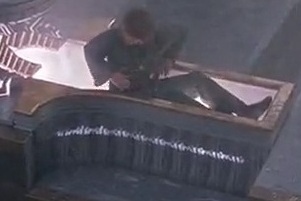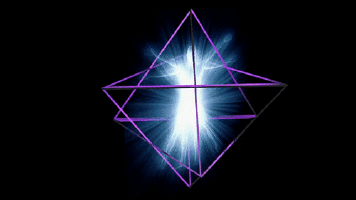
Master Ahmet Kayhan used two sources from outside the Islamic/Sufic tradition. One of these was the Peace Prayer attributed to Saint Francis (available here). The other was Édouard Schuré's chapter on Hermeticism from The Grand Initiates (Paris, 1889).
A Turkish historian, Enver Behnan Shapolyo, had translated parts of that chapter into Turkish and used them in his History of the Prophets (1968). This is where the Master found the text. He excerpted it and used to have it read in his group discussions.
The Master always made it crystal clear that the text was important primarily for its treatment of Illicit Sex (Trial by Passion/Lust). In addition, he would make brief, illuminating comments highlighting other parallels with Sufism. He also told us that a formal ceremony of this sort was no longer necessary today, because the trials and training occur in the real-life circumstances of each individual in Sufism.
Over the years, I collected these comments. The Master would sometimes pass over in silence topics he had earlier commented on or would later do so. The result is as complete a documentation of them as I am able to muster.
I have earlier presented Schuré's modified text for interested readers (here and here). What I have not previously done is to present the Master's comments in conjunction with it. I now remedy this situation. The Master's comments are interspersed throughout wherever he made them, and are indicated in bold. Any additions of mine will be placed in [brackets as italics].
I believe these comments are invaluable for shedding light on both Hermeticism and Sufism. His explanations make it clear that he is interpreting some things symbolically. They also serve as a check on Schuré's imaginative account. As you'll see, it turns out to be vindicated at many points.

Hermeticism is the entry door to Sufism and asceticism. The seven levels of selfhood were explained here. The tradition of Hermeticism continues in Islam, in Sufism.
The Initiation Ceremonies of Hermeticism
These all exist in Sufism. What is described in Hermeticism all occur and appear during the Spiritual Journey. But not in an exam hall like it is there. Rather, within normal life and during meditation.
 Aspirants wishing to join the Hermetic religion would go to the famous temples at Thebes or Memphis. The high priest, or hierophant, would meet the aspirant in the huge and magnificent temple. The priest would take him to his room and ask who he was, where he came from, and where he had studied. He would size up the aspirant’s intelligence and aptitude. If he had the capacity to comprehend advanced knowledge, he would keep him there. Otherwise, he would be sent away.
Aspirants wishing to join the Hermetic religion would go to the famous temples at Thebes or Memphis. The high priest, or hierophant, would meet the aspirant in the huge and magnificent temple. The priest would take him to his room and ask who he was, where he came from, and where he had studied. He would size up the aspirant’s intelligence and aptitude. If he had the capacity to comprehend advanced knowledge, he would keep him there. Otherwise, he would be sent away.
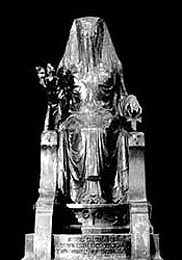 National education is now moving in this direction, too.
National education is now moving in this direction, too.
The priest then took the youth and conducted him through the inner courts and a corridor carved in stone, open to the sky and bordered with sphinxes. At the end of the passage, there was a small temple which served as an entrance to the underground crypts. The door was disguised by a life-size statue of Isis. The goddess, sitting in a position of meditation and contemplation, held a closed book in her lap. Her face was covered by a veil, and beneath the statue was the inscription: “No mortal has lifted my veil.”
[“You cannot see My face, but I will manifest Myself to this mountain. If it remains, you can see Me.” But when the Lord manifested Himself on the mountain, it disintegrated (7:143). This means: “You can see Me only through Me.”]
The hierophant said to the youth: “This is the door to the hidden sanctuary. Look at these two columns. The red one symbolizes the ascent of the spirit into the light of Osiris. The black one signifies the imprisonment of the soul in the body. Whoever approaches our science and teaching risks his life. Madness or death await the weak and the wicked. Only the strong and the good find life and immortality. Many reckless ones have entered this door, and have not come out alive. This is such an abyss that only the fearless can emerge from it again. Therefore, consider carefully the dangers you will face. If you do not trust yourself, give up the quest, for once this door is closed behind you, it will not be opened.”
 The aspirant, after listening to these words in fear, would summon all his courage, and once he said: “I accept your terms,” the priest would lead him to the outer court and commend him to the temple servants. The aspirant would be kept in the temple for one week; he would be requested to perform the lowliest chores, would listen to hymns and be forbidden to talk about worldly affairs. He would complete his weekly seclusion here.
The aspirant, after listening to these words in fear, would summon all his courage, and once he said: “I accept your terms,” the priest would lead him to the outer court and commend him to the temple servants. The aspirant would be kept in the temple for one week; he would be requested to perform the lowliest chores, would listen to hymns and be forbidden to talk about worldly affairs. He would complete his weekly seclusion here.
When the evening of ordeals arrived, two assistants led the candidate to the door of the secret sanctuary. The aspirant was now at the beginning of an ordeal full of mysteries. They entered a dark, dismal corridor without any visible exit, lined on both sides with human-bodied and animal-headed statues, and the statues of lions, bulls, hawks and snakes seen dimly in the torchlight. The requirement was to go through the passage without uttering a single word. At the end of this sinister passage were a mummy and a human skeleton.
These human-bodied, animal-headed statues are all within a person. They describe various levels of selfhood. A master witnesses these in his own body during his period of asceticism. The disciple is scared as he passes these. The fear of death—“You cannot pass.” Also, these all appear during meditation [tafakkur]. They are the ugly forms within a person’s own self. Then, as one is purified, they assume beautiful forms.
The two assistants pointed to a hole in the wall in front of the novice. This was the entrance to a corridor so low that it was impossible to pass through without crawling. One of the assistants said to the youth: “If you want you may turn back from here, because the door is not yet closed. You may return now. But if you continue, you cannot turn back.” Once the youth replied: “I will continue,”
The Critical [lawwama] Self.
he was handed a small torch, and the door of the sanctuary was quickly shut behind him with a loud bang.
[The light:] This is Unification, Invocation.

Trial by Death
The youth knelt down to crawl into the passage.
Prostration.
Hardly had he eased through when he heard a voice coming from the end of the tunnel. This voice would say: “Fools who covet knowledge and power perish here!”
Due to a strange acoustical phenomenon, the sentence was echoed seven times. Nevertheless, he had to move forward. After a while the corridor widened, but now began to incline downward more sharply. Finally, the youth would come across a hole, into which an iron ladder disappeared. He climbed down this ladder. At the lowest rung, his frightened gaze looked downward into a terrifying abyss. Return was impossible, and beneath him a black, bottomless pit yawned.
This is asceticism.
In order to save his life he looked around, and finally noticed a small crevice on his right. There was a staircase here by which he could escape. Right away, he climbed up the spiralling stairs carved into stone, and eventually came across a bronze grating. This led to a hallway supported by huge columns in the shape of draped female figures. Two rows of symbolic frescoes could be seen on the wall. All these symbols had a hidden meaning. There were 11 frescoes on either side of the hallway, and the lights in the hands of the beautiful column-statues illuminated these pictures.
A magus, the guardian of the sacred symbols, opened the bars and welcomed him with a smile. He said: “You have passed the first test successfully. Congratulations,” and then, taking him across the hall, explained the sacred meanings. Under each of these pictures were a letter and a number. There were 22 symbols that represented the first 22 Mysteries.
These are the Names of God.
They constituted the alphabet of secret science. These letters were the keys to the secrets of the universe bestowed by God Almighty. Employed by the right will, they became the source of all wisdom and power.
Every letter and number corresponded to a triadic law, having repercussions in the divine world, the intellectual world, and the physical world. For example the letter A, which corresponded to the number 1, represented, in the divine world: Absolute Being from which all beings emanate; in the intellectual world: the unity, origin and synthesis of numbers; and in the physical world: Man, the head of all beings, with his capacity to attain infinity.
He’s now going toward the Tranquil [mutmainna] Self.
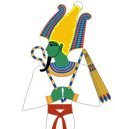 The arcanum of “A”, which symbolized attainment of the Godhead, was represented by a magus dressed in the attire of Osiris, with a scepter in his hand and wearing a white robe and gold crown. The white robe stood for purity, the scepter for authority, and the gold crown for enlightenment by the light of Heaven.
The arcanum of “A”, which symbolized attainment of the Godhead, was represented by a magus dressed in the attire of Osiris, with a scepter in his hand and wearing a white robe and gold crown. The white robe stood for purity, the scepter for authority, and the gold crown for enlightenment by the light of Heaven.
The guardian of the symbols led the novice along, explaining the arcana one by one. Concerning the crown, he remarked: “Free will, which is joined to God in order to manifest truth and effect justice, participates in divine power even while in this world. This is an everlasting reward to spirits.”
The neophyte listened to these explanations with surprise, and the first glimmers of understanding began to take shape in his mind.
Trial by Fire
Difficulties. Not real fire, but the hardships of life.
 The magus now opened another door, leading to a long, narrow corridor, at the end of which a red-hot furnace could be spied. The novice had to pass through it. He trembled with fear, whereupon the priest said: “My son, death frightens only weak minds. I myself once crossed this fire like a bed of roses.”
The magus now opened another door, leading to a long, narrow corridor, at the end of which a red-hot furnace could be spied. The novice had to pass through it. He trembled with fear, whereupon the priest said: “My son, death frightens only weak minds. I myself once crossed this fire like a bed of roses.”
It becomes easy. When one comes to the Tranquil [Contented] Self, everything becomes easy.
With that, the gate of the hall of secrets closed behind the newcomer. Approaching the fire, he perceived that it was but a visual illusion created by artifices, and quickly passed through a narrow path in the middle.
Trial by Water
His third test was to go through a pool of stagnant black water, lit by the flames of the fire already left behind. The ordeals had by this time left him trembling and exhausted.
Trial by Passion
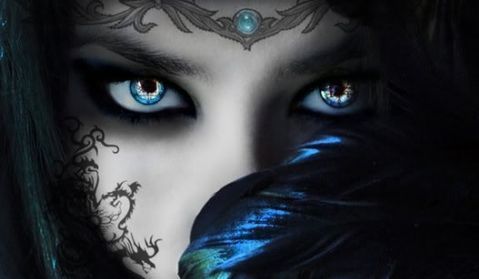
This is the crucial point. Let’s throw it away. The secrets of the universe. To abandon those and fall into Forbidden Lust [carnal sin]... [What a pity.]
Next, two assistants led him to a dim grotto where a soft couch could be seen in the flickering light of a bronze lamp. Here he was stripped and bathed, perfumed with exquisite essences, dressed in fine linen and told to rest and wait for the hierophant.
Weak with fatigue, the novice stretched on the bed and fell asleep. Soon, tones of lascivious music reached his ears. The sounds of a harp and a flute enwrapped his soul, arousing passionate feelings in him.
While he was in this semiconscious state, a woman approached.
 This woman of breathtaking beauty, wearing a dress of transparent dark-red gauze and a necklace, held a cup crowned with roses in her left hand. The youth trembled at the sight of this woman with shining eyes and lips of fire, staring at this splendid example of female anatomy. Why was she here? There was no one else in the grotto other than the two of them. The woman was reaching out to him, making plain that they should lie on the bed together, and murmuring in a husky voice: “Are you afraid of me, noble stranger? I come to you with the reward of the victorious as a present. I bring you the cup of happiness by which you may forget your troubles. Come, let us make love and spend hours of delight together.” So saying, she sat on his bed and did things to arouse his passion.
This woman of breathtaking beauty, wearing a dress of transparent dark-red gauze and a necklace, held a cup crowned with roses in her left hand. The youth trembled at the sight of this woman with shining eyes and lips of fire, staring at this splendid example of female anatomy. Why was she here? There was no one else in the grotto other than the two of them. The woman was reaching out to him, making plain that they should lie on the bed together, and murmuring in a husky voice: “Are you afraid of me, noble stranger? I come to you with the reward of the victorious as a present. I bring you the cup of happiness by which you may forget your troubles. Come, let us make love and spend hours of delight together.” So saying, she sat on his bed and did things to arouse his passion.
If the young man fell for this seductress, if he accepted her embraces, she would make him drink from the cup.
[If he begins to kiss the woman’s chin:] That’s it. Finished. All his labors have gone down the drain. May God preserve us all. That’s why those who come to me are few. I mention the two points [Illicit Gain and Illicit Sex], they don’t come again.
After the wild satisfaction of his desire, his head began to swim and his throat to burn. Soon he was in a deep sleep, brought on by the medicated wine he had drunk.
The temptress would vanish. When he awoke, he saw the hierophant standing over him with a stern face. The priest said: “You were successful in your first trials. You overcame death, fire and water, but could not conquer your self. You, who sought the heights of mind and knowledge, could not resist the first temptation of the senses and fell into the abyss of matter. He who is a slave to his passions lives in darkness. You preferred darkness to light, so stay there henceforth. You have saved your life, but lost your freedom. From now on, you will be a slave of this temple. If you try to escape, you will die.”
One passes all the tests, but gets stuck at lust. If one surmounts this, too, one is a saint. Two professors [masters-to-be] got stuck at this point. I chose this text because it deals with lust. Education begins after the Trial of Lust. Otherwise, one remains there. A seventy-year old man told me, “Lust still moves within me.”
 If, on the other hand, the aspirant turned down the temptress, he would have succeeded in this last trial as well. Then, twelve priests bearing torches took and escorted him into the hall of Isis. Magi standing in a semicircle awaited him. In the splendidly lighted hall, a colossal statue of Isis held a gold rose at her breast and wore a crown of seven rays.
If, on the other hand, the aspirant turned down the temptress, he would have succeeded in this last trial as well. Then, twelve priests bearing torches took and escorted him into the hall of Isis. Magi standing in a semicircle awaited him. In the splendidly lighted hall, a colossal statue of Isis held a gold rose at her breast and wore a crown of seven rays.
And there are seven pleats on the headpiece of the Rufai Order [corresponding to the seven levels of the self].
Her son Horus was in her arms. [Horus, symbolized by a hawk, was among the first deities of the Egyptians.]
The hierophant, clothed in velvet, swore the newcomer to silence and submission. Then he greeted him as a brother and a future initiate. What the youth had experienced up to this point was the entrance examination and ceremony.
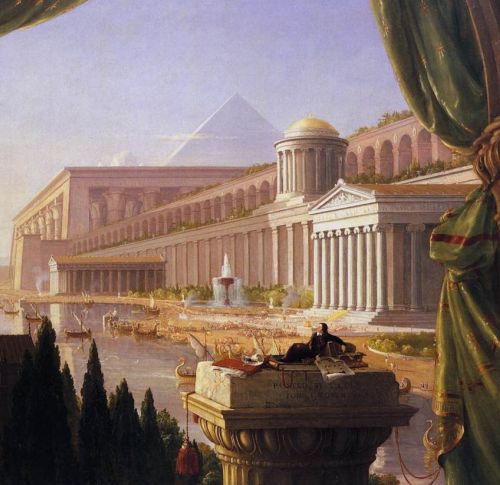
Training
Now began long years of study and apprenticeship. He was assigned a cell to live in, and was instructed by teachers. He could stroll in the halls and courtyards of the temple, as large as a city. He studied hieroglyphics inscribed on the columns, as well as the history of mankind, minerology, botanics, medicine, architecture and sacred music.
The temple was, for all practical purposes, a university. Only the most intelligent students were accepted, and went through sophisticated training. Many of the positive sciences saw daylight here. Physics, chemistry, geometry, and astronomy were quite advanced. The laws of natural phenomena were discovered in this environment.
Hermeticism was more a center for meditation than religion. The existence and Unity of God was known via this education.
The young people here were researchers as well as students. They were all meditators and thinkers. To them, the advance of science was grounded in the birth of truth in the human spirit, and thus the latter had to be creative. But this was possible only after long and arduous effort.
Their teachers did not help them in anything. They were amazed at this, but in time discovered the reasons.

The young disciple tried to decipher the meaning of the hieroglyphs. In time, the invisible and impalpable truth slowly began to dawn in his heart. Sometimes he asked one of the magi: “Will I be able someday to smell the rose of Isis, to see the light of Osiris?” to which the reply was: “That depends not on us, but on you. Truth cannot be given. Either one finds it in oneself, or one does not.”
The meaning of a Saying: “Who knows his self knows his Lord.”
“We cannot force you; you must become an adept yourself. Do not rush the blossoming of the divine flower. If it is destined to come, it will in its own good time. Your duty is to work and pray.”
And so the disciple returned to his studies. Many years went by. He meditated and tried to discover truth. He surrendered wholly to God and dedicated himself to truth.
The Conquest, or Opening

He’s trying to become a saint. To die before death.
[“Die before you die”—the Prophet.]
One day, the disciple found the hierophant standing beside him. The master said: “My son, the time is coming when truth will be revealed to you. For you have already descended to the depths of your heart and there found the life divine. By the purity of your heart, by your love of truth and your self-denial, you have earned that right and proven your worthiness. But no one can see Osiris’ light without dying and being resurrected first. We shall take you to the crypt. Don’t be afraid, for you are one of us already.”
Somuncu Baba [the Father of Loaves] in Darende did it like that, too. Hadji Bektash, Rumi, Yunus Emre, Hadji Bayram Wali, they all passed through this. Yunus Emre said, “I was raw, I cooked, I burned.”
At dusk the priests, bearing torches, took the adept into the underground crypt, and stopped in front of an open sarcophagus made of marble.
“No man escapes death,” said the hierophant, “and every soul, having died, is destined to resurrection. Lie down in this coffin, and wait for the light to dawn upon you.”
 The initiate lay down in the sarcophagus, and the priests departed in silence. A funeral chant could be heard, coming from afar. The coldness of the tomb, the darkness, the silence and the sadness of the chant all acted upon him. He felt he was dying.
The initiate lay down in the sarcophagus, and the priests departed in silence. A funeral chant could be heard, coming from afar. The coldness of the tomb, the darkness, the silence and the sadness of the chant all acted upon him. He felt he was dying.
Eventually he saw a far distant, shining point, coming closer and growing larger until it became a five-pointed star
[“When the night covered Abraham, he saw a star” (6:76). “By the Star when it plunges” (53:1).]
whose rays included all the colors of the rainbow.
All these exist in the Naqshi Order. At that station, all those colors are witnessed. They’ve included this lesson in Masonry. That is, this star exists in Masonry. [Freemasonry:] We don’t belong to the Masons, the Masons belong to us. If Masons came here, I’d explain all this to them. Yusuf of Hamadan, the Grand Saint [Abdulqader Gilani], Ahmet Yasawi—if they study these, all Masons will become Moslems. [According to Sir Richard Burton, Sufism was “the Eastern parent of Freemasonry.”]
[“He stood poised on the highest horizon, Then approached and came closer” (53:6-8).]
The star grew into a sun,
[“Abraham saw the sun” (6:78). “And was at the distance of two bows...” (53:9).]
The veils are lifted there. At that station, the eyes are shut, you’re in the Presence, all these happen. These things are unveiled.
[“... or even lower/nearer. And He revealed to His servant (Mohammed) what He revealed... And he certainly saw Him in another descent, at the Lote-Tree of the Boundary... When there covered the Lote-Tree that which covered it. His sight never swerved, nor did it stray. Indeed, he (Mohammed) saw one of the greatest signs of His Lord” (53:9-18).]
which disappeared and gave way to a bud that blossomed into a beautiful flower. This was the mystical rose of Isis, the rose of wisdom. Soon it, too, vanished into a formless white cloud. The cloud, after assuming various forms, condensed in the shape of a human being. This was a veiled, smiling woman, a manifestation of Isis holding a scroll of papyrus in her hand.
She slowly approached the tomb and said: “I am your invisible sister, your divine soul. This is the book of your life. Its written pages contain your past life. In its blank pages, your future life will be written. Now you know who I am. I shall come whenever you call me.”
[Sophia/Wisdom, the angelic apparition of opposite sex that manifests toward the end:] Finally she’s back again. She says, “I’m your spirit.” Your spirit. Men and women are all your brethren from here on. This is the last topic. Some saints call this hutam [hitan: obstacle]. If one gets tangled in that, one remains here, one can’t progress.
Yet this, too, was a veil, an obstacle in the way, to be transcended perhaps now, perhaps in the future. Then, the adept would be raised into the light of Osiris, and be merged into the ineffable Essence of the universe of which it is impossible to speak.
[“No soul knows what delight awaits them as the reward for their deeds.” (32:17). “I have prepared for my servants what no eye has seen, no ear has heard, and no human mind has conceived” (The Book of Forgiveness, 20.1881).]
[Empty pages—one is reborn:] In our religion, at that point the Eye of the Heart of great masters is opened. There, the third university, the final university begins, One becomes a Perfect Human. Although one doesn’t see the Face of God, one hears His voice and can converse with Him.
[In Islam, Moses is known as “the one who speaks with God.” “When Moses reached the fire, a voice called out, 'O Moses, I am your Lord. Remove your sandals, for you are in the sacred valley of Tuwa. I have chosen you. Listen to Revelation'” (20:11-13).]
The disciple felt the love of wisdom flood his heart. Falling into a deep sleep, he found the hierophant and magi leaning over him when he awoke. The high priest gave him a glass of sherbet,
That sherbet has a color between an orange and a lemon. After drinking that, nothing remains of the Base [ammara] Self. There’s also an Imaginal banquet. They bring food. [Culmination, fulfillment.]
[“Their Lord will give them a pure drink” (76:21). “Said Jesus son of Mary, 'O God, our Lord, send down for us a banquet from heaven, that shall be a festival for us, the first and last of us, and a sign from You. And provide for us; You are the best of providers'” (5:114).]
and said: “You are resurrected. Come celebrate with us, and tell us about your journey in the light of Osiris.”
After dining together, the master took the new initiate to the observatory of the temple, and instructed him in the mysteries of Hermes. He related to him the Vision of Hermes/Idris, never written on any papyrus but always orally transmitted. He told the initiate about the Ascent of Hermes, how he saw the Seven Heavens, and even the Almighty Himself....

All these are within this city [the body]. The universities are within this body. To live differently in this university. May God grant it.
A visitor: They didn’t explain anything to the students.
Yes! [The same holds in Sufism.]
A visitor: Hermeticism doesn’t exist today.
It hasn’t existed for a thousand years. They called that man [Hermes] the prophet Idris [Enoch], according to one rumor. He’s not Idris, but he made the Ascension of the spirit. That’s why I love that man. [Idris was a prophet who, like Hermes, made the Ascension. The Koran speaks of him: "We raised him to a high place" (19:57). The Master explained that he was raised to the sun.]
A visitor: The spiritual side of philosophy disappeared.
It passed away. Why? Because the Mohammedan Light [Islam] was going to come. Plato was an intelligent man. He wasn’t a Moslem, but they paved the way. Why did the physical and spiritual sciences diverge? In order to pave the way for Mohammed. [Like protective leaves parting to make way for a flower shoot.]
